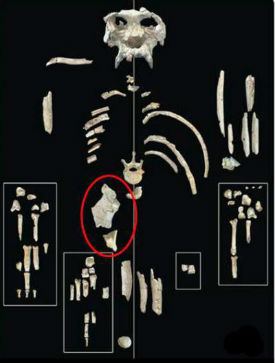Pierolapithecus catalaunicus
Online Biology Dictionary
|
|
EUGENE M. MCCARTHY, PHD
 P. catalaunicus - Artist's reconstruction (Image: Wikimedia, Catalaalatac)
P. catalaunicus - Artist's reconstruction (Image: Wikimedia, Catalaalatac) Remains of the ilium (circled in red) suggest this ape had a wide pelvis. Credit: University of Missouri.
Remains of the ilium (circled in red) suggest this ape had a wide pelvis. Credit: University of Missouri.
Researchers who unearthed the fossilized remains of an 11.9-million-year-old ape in Spain (at Hostalets de Pierola, Catalonia) in 2002 assigned it the name Pierolapithecus catalaunicus. It was described by a team of Spanish paleoanthropologists led by Salvador Moyà-Solà (Moyà-Solà. et al. 2004).
They suggest this creature could have been the last common ancestor of the great apes—chimpanzees, orangutans, bonobos, and gorillas—as well as of humans. This hypothesis is, however, contested, mainly because the specimen was found in Spain, which has never been seen as a hotbed of hominoid evolution; all extant wild populations of great apes exist only in Asia or Africa. Moreover, it has been widely assumed that Africa was the location where apes evolved into humans. On the other hand, it is well known that the European landmass has been in direct contact with Africa at various times in the past, so dispersal between the two continents might well have occurred.
Certain features, too, seem to separate this creature from previously known apes. For example, the fingers of the Pierolapithecus catalaunicus are unlike those of modern great apes. And the pelvis, too, is wider than that of the ancient ape Proconsul nyanzae, which lived approximately 18 million years ago. Moyà-Solà et al. assert that this latter difference may have given this ape greater balance and stability while moving using its forelimbs.
Rather than a full common ancestor, it has also been suggested that this ape was ancestral to humans, chimpanzees and gorillas, but not orangutans. This idea, however, has not gained wide acceptance.
Perhaps we are not from the apes alone?

|
References:
Moya-Sola, S., Köhler, M., Alba, D. M., Casanovas-Vilar, I., Galindo, J. 2004. Science, 306 (5700): 1339–1344.
Hammond, AS, Alba, DM, Almécija, S, Moyà-Solà, S. 2013. J. Hum Evol., Mar 29.
Facts about Pierolapithecus:
Age: 13 mya (Miocene).
Habitat: Probably open forest or rain forest.
Pronunciation: pee-ə-ROLL-ə-PITH-ə-kəs.
Etymology: The name of this ape was constructed by adding the Greek suffix -pithecus, meaning "ape," to the name of the town,Hostalets de Pierola, where it was found, and catalaunicus refers to Catalonia.